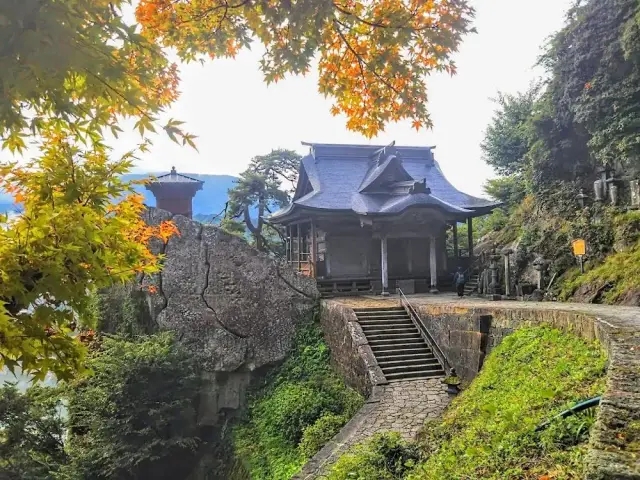https://www.dekitabi.com/itinerary/yamagata-city-essential-tour
Nestled in Japan’s Tohoku region, Yamagata Prefecture is a treasure trove of cultural and historical wonders. Among its many attractions, Kajo Park, Risshokuji Temple, and Nanukamachi Gotenzeki stand out for their unique blend of natural beauty, historical significance, and architectural splendor. This guide will delve into these remarkable sites, offering insights into their historical context, cultural importance, and what makes them must-visit destinations.
Kajo Park: The Heart of Yamagata’s History

https://www.dekitabi.com/attraction/kajo-park
Kajo Park (霞城公園) is a sprawling historical park located in the center of Yamagata City. It is the site of the former Yamagata Castle, a structure that played a pivotal role in Japan’s feudal history. The park itself is a serene place, offering a peaceful retreat from the hustle and bustle of city life. It is especially renowned for its stunning cherry blossoms in the spring, making it a popular spot for hanami (flower viewing).
Historical Significance
Yamagata Castle, originally constructed in 1356, was the seat of the Mogami clan during the Edo period. The castle’s strategic location allowed it to serve as a military and administrative hub in the region. Although the original structure was dismantled in the late 19th century, the park preserves the castle’s legacy through its beautifully restored walls and moats. The park’s main features include the remnants of the castle’s stone walls, a reconstructed watchtower, and the surrounding gardens that reflect the design of the original castle grounds.
Attractions and Activities
Visitors to Kajo Park can explore various historical features, such as the castle’s main gate and the impressive stone foundations that hint at the grandeur of the original structure. The park’s well-maintained paths and open spaces are perfect for leisurely strolls or picnics, offering a tranquil environment to appreciate the beauty of nature and history combined. Additionally, the park hosts seasonal events, including traditional festivals and cultural performances, which provide a deeper understanding of the local traditions and heritage.
Risshokuji Temple: A Spiritual Sanctuary

https://www.dekitabi.com/attraction/risshaku-ji
Risshokuji Temple (立石寺), located a short distance from Kajo Park, is an ancient Buddhist temple that holds significant religious and historical importance. Founded in 1336 by the renowned monk, Honen, the temple is known for its distinctive architectural style and serene atmosphere.
Architectural Marvel
The temple’s main hall, or Hondo, is a prime example of traditional Japanese temple architecture. Its wooden structure, adorned with intricate carvings and delicate paintings, reflects the artistry of the era in which it was built. The temple complex includes a pagoda, bell tower, and various smaller shrines, each contributing to the site’s spiritual ambiance.
Spiritual and Cultural Importance
Risshokuji Temple is not only a place of worship but also a center of cultural preservation. The temple’s serene surroundings, coupled with its historical artifacts, offer visitors a glimpse into Japan’s religious and cultural heritage. The temple’s grounds are ideal for meditation and reflection, providing a peaceful environment that contrasts with the more bustling attractions of Yamagata City.
Nanukamachi Gotenzeki: A Glimpse into Feudal Japan

https://www.dekitabi.com/attraction/nanukamachi-gotenzeki
Nanukamachi Gotenzeki (七日町御殿跡) is a historic site that once served as the residence of the samurai during the Edo period. Located in the heart of Yamagata City, this site offers a fascinating look into the life and times of Japan’s feudal era.
Historical Context
Nanukamachi Gotenzeki was the official residence of the local samurai, known for its strategic importance and grand design. The site has been preserved to reflect its historical significance, with remnants of the original structures still visible. Visitors can explore the foundation stones and layout of the residence, gaining insight into the architectural style and living conditions of the samurai.
Cultural Heritage
The site offers a unique opportunity to experience the historical atmosphere of feudal Japan. Interpretive signs and exhibits provide context about the samurai’s role in society, their daily life, and the broader historical events that shaped the region. The surrounding area also features traditional gardens and historical buildings that complement the site’s cultural narrative.
Combining History and Culture
Yamagata Prefecture’s Kajo Park, Risshokuji Temple, and Nanukamachi Gotenzeki offer a rich tapestry of historical and cultural experiences. Each site provides a unique perspective on Japan’s past, from the strategic importance of Kajo Park’s castle ruins to the spiritual significance of Risshokuji Temple and the samurai heritage of Nanukamachi Gotenzeki.
Tips for Visitors
- Best Time to Visit: Spring is an ideal time to visit Kajo Park due to the cherry blossoms. For Risshokuji Temple, any season offers a tranquil experience, while Nanukamachi Gotenzeki is best explored with a guided tour to fully appreciate its historical context.
- Getting There: All three sites are conveniently located in Yamagata City. Kajo Park is centrally located and easily accessible by public transportation. Risshokuji Temple and Nanukamachi Gotenzeki are a short drive or bus ride away.
- What to Bring: Comfortable walking shoes are recommended, as the park and temple grounds involve a fair amount of walking. A camera is also advisable to capture the stunning scenery and historical architecture.
- Local Cuisine: After exploring these historical sites, visitors can enjoy local Yamagata cuisine. The region is famous for its delicious soba noodles, fresh mountain vegetables, and unique local sweets.
Conclusion
Kajo Park, Risshokuji Temple, and Nanukamachi Gotenzeki each offer a unique window into Yamagata Prefecture’s rich historical and cultural tapestry. Whether you’re drawn to the architectural splendor of a former castle, the serene ambiance of an ancient temple, or the remnants of a samurai residence, these sites provide a memorable and enriching experience. Embrace the opportunity to delve into Japan’s storied past and enjoy the serene beauty that Yamagata has to offer.


Leave a Reply